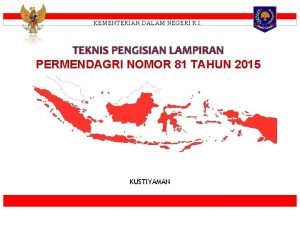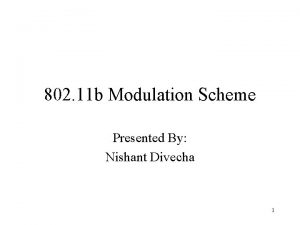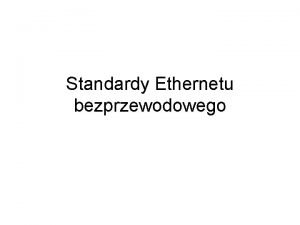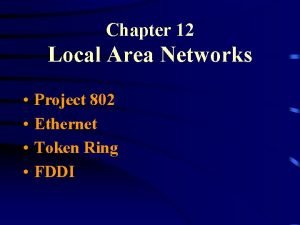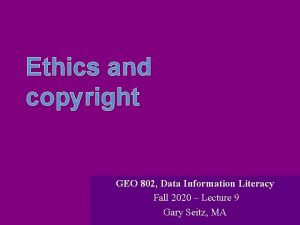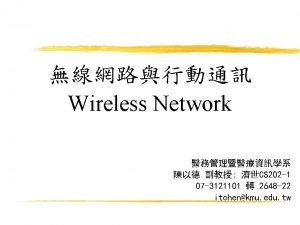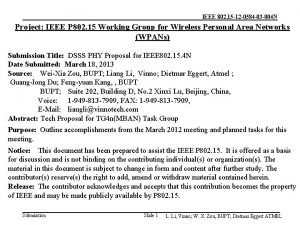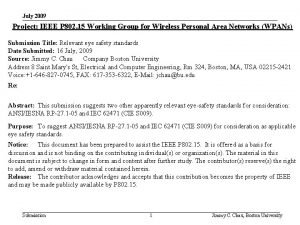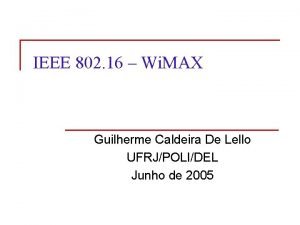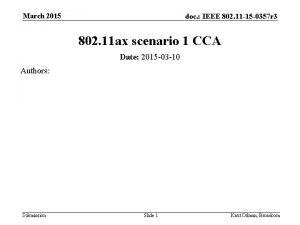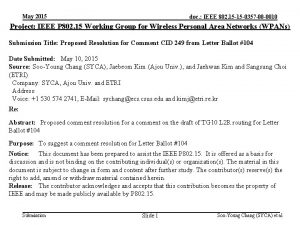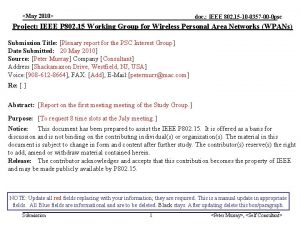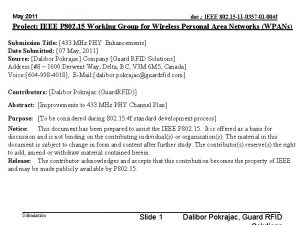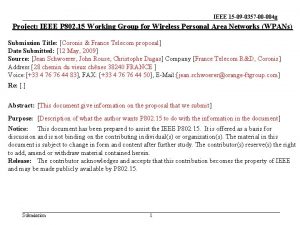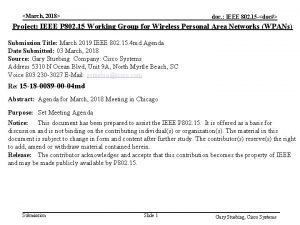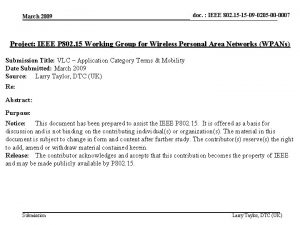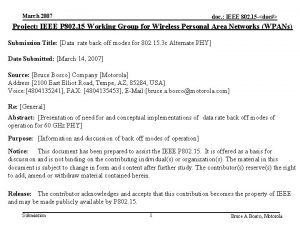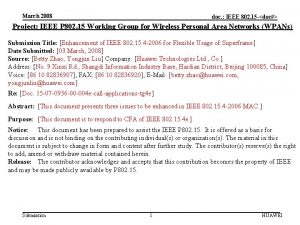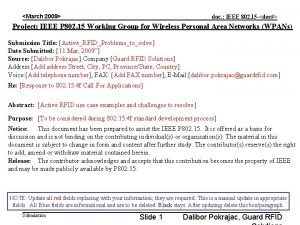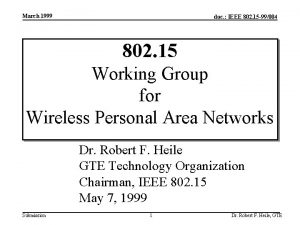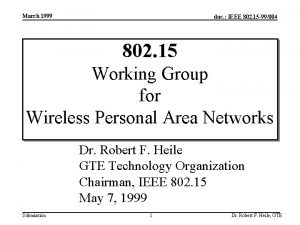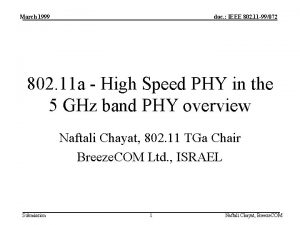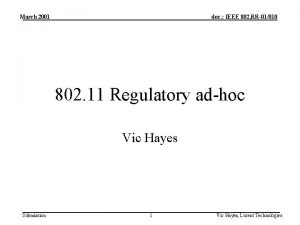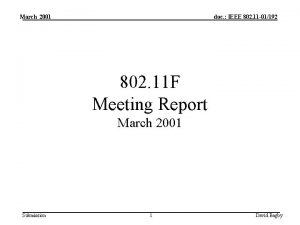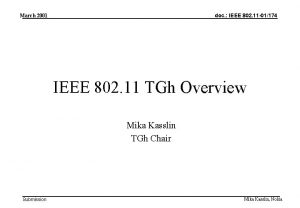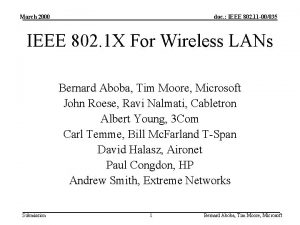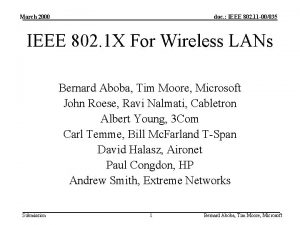March 2015 doc IEEE 802 11 15 0357























- Slides: 23

March 2015 doc. : IEEE 802. 11 -15 -0357 r 0 802. 11 ax scenario 1 CCA Date: 2015 -03 -08 Authors: Submission Slide 1 Knut Odman, Broadcom

March 2015 doc. : IEEE 802. 11 -15 -0357 r 0 Abstract Ref. 11 -14 -0980 -06 -00 ax-simulation-scenarios. docx • Simulation of Scenario 1 where ED/CCA was swept over a range of -87: 5: -52 showed that different BSS react very differently to a global CCA setting. • The smooth curves seen on simulations of total or average throughput get much more complicated when you look at individual BSSs. Submission Slide 2 Knut Odman, Broadcom

March 2015 doc. : IEEE 802. 11 -15 -0357 r 0 References for comparison DCN Title Affiliation Comparison 11 -14 -0833 -00 Residential Scenario Sensitivity and Transmit Power Control Simulation Results Interdigital Slide 7: Five floor reuse 1 11 -14 -0578 -00 Residential Scenario CCA/TPC Simulation Discussion Interdigital Slide 7: Five floor reuse 1 11 -14 -0880 -01 Increased Network Throughput with Media. Tek Channel Width Related CCA and Rules Slide 9: 80 MHz CCA 11 -14 -0889 -03 Performance Gains from CCA Optimization Broadcom Slide 13&14 11 -14 -0846 -00 CCA Study in the Residential Scenario Qualcomm Slide 17, default pwr, mean 11 -14 -0861 -00 Impact of CCA adaptation on spatial Nokia reuse in dense residential scenario Slide 3 Submission Slide 6, Rx sensitivity

March 2015 doc. : IEEE 802. 11 -15 -0357 r 0 Random layout (uniform) Multi-floor building • 3 floors, 3 m height in each floor • 2 x 4 apartments in each floor • Apartment size: 10 m x 3 m • 4 STA/BSS, 1 BSS/apartment Submission Slide 4

March 2015 doc. : IEEE 802. 11 -15 -0357 r 0 Parameters used MCS AP #of TX antennas AP #of RX antennas STA #of TX antennas STA #of RX antennas Noise Floor PHY parameters Adaptive MCS 0 -MCS 8 1 1 -88 d. Bm MAC parameters Center frequency, BSS BW and primary channels 5 GHz: 80 MHz, reuse 1 (all BSS on same channel) Aggregation No A-MSDU, A-MPDU adaptive, max 64, μ = 37 and σ = 21. All other parameters from 0980 r 6 Submission Slide 5

March 2015 doc. : IEEE 802. 11 -15 -0357 r 0 Sum of all data flows Submission Slide 6

March 2015 doc. : IEEE 802. 11 -15 -0357 r 0 Very different between BSS Submission Slide 7

March 2015 doc. : IEEE 802. 11 -15 -0357 r 0 Some BSS have little or no throughput Total L 4 throughput for BSS index 2 (AP = 10) Total L 4 throughput for BSS index 6 (AP = 30) Total L 4 throughput for BSS index 8 (AP = 40) Total L 4 throughput for BSS index 11 (AP = 55) : : 0. 005318 Mbps 0. 006078 Mbps 0. 000000 Mbps 0. 148150 Mbps Total L 4 throughput for BSS index 12 (AP = 60) : 0. 038747 Mbps Submission Slide 8

March 2015 doc. : IEEE 802. 11 -15 -0357 r 0 BSS with bad throughput AP is far away in a corner and the STA are spread out Submission Slide 9

March 2015 doc. : IEEE 802. 11 -15 -0357 r 0 Some BSS have great throughput Total L 4 throughput for BSS index 1 (AP = 5) Total L 4 throughput for BSS index 3 (AP = 15) Total L 4 throughput for BSS index 15 (AP = 75) Total L 4 throughput for BSS index 16 (AP = 80) : : 174. 363054 Mbps 196. 136497 Mbps 196. 327193 Mbps 196. 270212 Mbps Total L 4 throughput for BSS index 18 (AP = 90) : 196. 346186 Mbps Total L 4 throughput for BSS index 22 (AP = 110) : 179. 021791 Mbps Submission Slide 10

March 2015 doc. : IEEE 802. 11 -15 -0357 r 0 BSS with good throughput AP is centered in BSS and distances between AP and STA are short or equal Submission Slide 11

March 2015 doc. : IEEE 802. 11 -15 -0357 r 0 In a “bad BSS”, no CCA setting helps Submission Slide 12

March 2015 doc. : IEEE 802. 11 -15 -0357 r 0 In a “good BSS” results are scattered -57 to -60 d. Bm seems to be an optimum. Submission Slide 13

March 2015 doc. : IEEE 802. 11 -15 -0357 r 0 CDF Throughput per BSS – all BSS Submission Slide 14

March 2015 doc. : IEEE 802. 11 -15 -0357 r 0 CDF Throughput per BSS – “bad” BSS Submission Slide 15

March 2015 doc. : IEEE 802. 11 -15 -0357 r 0 CDF Throughput total of all BSS Submission Slide 16

March 2015 doc. : IEEE 802. 11 -15 -0357 r 0 Compare 11 -14 -0833 -00 Normalized (per BSS) Average Throughput (Mbps) -90 d. Bm -80 d. Bm -70 d. Bm -60 d. Bm -50 d. Bm 11 d. Bm 9. 1 19. 2 22. 3 21. 0 19. 2 14 d. Bm 7. 9 17. 1 22. 2 22. 7 19. 7 17 d. Bm 6. 6 12. 4 22. 6 22. 7 20. 4 AP tx power is 20 d. Bm, STA antenna gain -2 d. Bi. Our result is similar to the 17 d. Bm power in the table. AGREE Submission Slide 17

March 2015 doc. : IEEE 802. 11 -15 -0357 r 0 Compare 11 -14 -0578 -00 Comparing to the 17 d. Bm Tx power column, we see much bigger differences between EDCCA settings. Submission Slide 18

March 2015 doc. : IEEE 802. 11 -15 -0357 r 0 Compare 11 -14 -0880 -01 “For intended 80 MHz transmission channel width, CCA for 80 MHz: -76 d. Bm” Our sims would suggest that -76 d. Bm is in the unpredictable area and that -60 to -57 d. Bm would be better on average. Submission Slide 19

March 2015 doc. : IEEE 802. 11 -15 -0357 r 0 Compare 11 -14 -0889 -03 In the same ballpark. AGREE Submission Slide 20

March 2015 doc. : IEEE 802. 11 -15 -0357 r 0 Compare 11 -14 -0846 -00 Optimal CCA for mean Reuse 1 default TX power Channel D PER curves Reuse 1 default TX power AWGN curves -72 -62 “Optimal CCA levels are highly dependent on parameter settings example, Tx Power, PER curves” Submission Slide 21 Our sim with 11 ax channel model looks closer to AWGN in this test. AGREE!

March 2015 doc. : IEEE 802. 11 -15 -0357 r 0 Compare 11 -14 -0861 -00 -62 d. Bm is close to our result. AGREE. Submission Slide 22

March 2015 doc. : IEEE 802. 11 -15 -0357 r 0 Conclusions • ED/CCA threshold can be set to optimize average or total throughput, however when looking inside individual BSS it gets much more complicated. • Optimum for one BSS can be a disaster for another. The optimum is dependent on path loss and interference. • For any DSC to be effective, it would probably have to be centrally managed and make decisions based on measurements from all nodes within radio range. Not an easy task! Submission Slide 23
 Bridges from 802.x to 802.y
Bridges from 802.x to 802.y Bridges from 802.x to 802.y
Bridges from 802.x to 802.y Poland national anthem lyrics
Poland national anthem lyrics Arquitetura ieee 802
Arquitetura ieee 802 802 ieee
802 ieee Ieee 802 standard
Ieee 802 standard Bluetooth ieee 802
Bluetooth ieee 802 802 ieee
802 ieee Ieee 802
Ieee 802 Ieee 802 family
Ieee 802 family Ieee 802 3 compliance
Ieee 802 3 compliance Wlan standards
Wlan standards Lampiran permendagri 81 tahun 2015
Lampiran permendagri 81 tahun 2015 802 11
802 11 Standardy 802
Standardy 802 802 5
802 5 802*12
802*12 Geo 802
Geo 802 802 family
802 family 802 protocols
802 protocols 802 15
802 15 Sybex ccna
Sybex ccna 09 802 0561
09 802 0561 802 16
802 16












